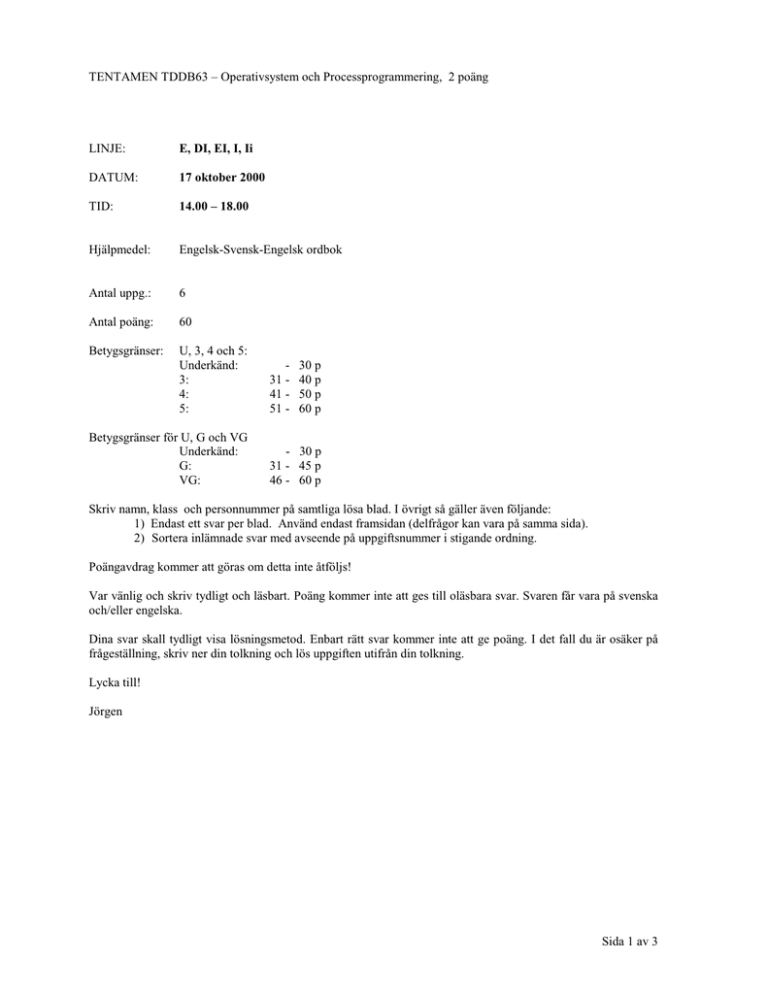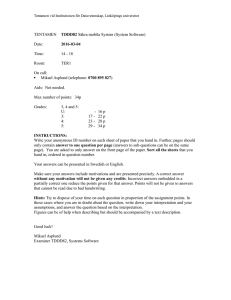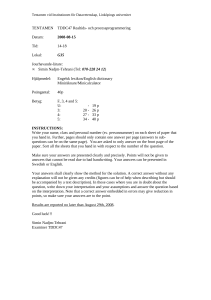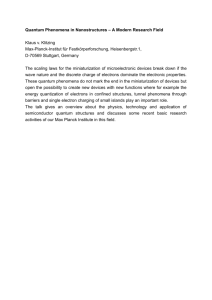Document 13150233
advertisement

TENTAMEN TDDB63 – Operativsystem och Processprogrammering, 2 poäng LINJE: E, DI, EI, I, Ii DATUM: 17 oktober 2000 TID: 14.00 – 18.00 Hjälpmedel: Engelsk-Svensk-Engelsk ordbok Antal uppg.: 6 Antal poäng: 60 Betygsgränser: U, 3, 4 och 5: Underkänd: 3: 4: 5: Betygsgränser för U, G och VG Underkänd: G: VG: 31 41 51 - 30 p 40 p 50 p 60 p - 30 p 31 - 45 p 46 - 60 p Skriv namn, klass och personnummer på samtliga lösa blad. I övrigt så gäller även följande: 1) Endast ett svar per blad. Använd endast framsidan (delfrågor kan vara på samma sida). 2) Sortera inlämnade svar med avseende på uppgiftsnummer i stigande ordning. Poängavdrag kommer att göras om detta inte åtföljs! Var vänlig och skriv tydligt och läsbart. Poäng kommer inte att ges till oläsbara svar. Svaren får vara på svenska och/eller engelska. Dina svar skall tydligt visa lösningsmetod. Enbart rätt svar kommer inte att ge poäng. I det fall du är osäker på frågeställning, skriv ner din tolkning och lös uppgiften utifrån din tolkning. Lycka till! Jörgen Sida 1 av 3 Q1: Computer System Structures (10 points) a) Explain what an interrupt vector is. Further, explain how system calls use interrupts. (2 points) b) How does synchronous I/O differs from asynchronous I/O. Which one is to be preferred? (3 points) c) Give a detailed explanation what happens when a context switch occurs in the system. Also discuss how the time for context switching can be reduced. (5 points) Q2: Scheduling and Process Synchronization (9p) a) Explain the concept of aging when used in scheduling. Further, explain how it can be used when using round robin scheduling and multi-level feedback queue scheduling. Identify a situation or class of scheduling problems when aging is not appropriate! (3 points) b) When are scheduling decisions made in an operating system? (2 points) c) As you know, round robin uses time quantum. How should the size of the time quantum be related to (i) the context switch time and (ii) the CPU burst times? (2 points) d) Explain how the method of critical regions is related to semaphores, and what the advantages are, if any, with respect to semaphores? (2 points) Q3: Deadlocks (7p) a) Explain the four necessary conditions that must hold simultaneously before a deadlock can occur? (4 points) b) Discuss three options for handling deadlocks. (3 points) Q4: Memory Management (7p) a) There are primarily three ways of implementing a page table. Either by placing it in dedicated registers, main memory, or using associative registers. Explain the differences between these three approaches. (3 points) b) What is Belady’s anomaly? (2 points) c) When using virtual memory management, explain how CPU utilization varies with the degree of multi-programming. (2 points) Q5: Protection (5p) Compare the two different concepts protection domain and access matrix. In your comparison, emphasize the degree of flexibility with respect to design and how easy it is to dynamically change the configuration later. Further, indicate if the principles are following the need to know principle or not. (5 points) Sida 2 av 3 Q6: Number crunching and Definition of Operators (22p) a) Scheduling: Consider the following set of processes (low priority number = high priority): Process P1 P2 P3 P4 P5 Arrival Time 0 5 5 8 12 Execution time 12 ms 5 ms 8 ms 6 ms 8 ms Priority 3 3 2 1 4 For each scheduling algorithm listed below, you are asked to draw and label Gantt charts, with arrival times and execution times, clearly outlining the execution order. Further, compute the average waiting time and the turnaround time for each case (time for context switching can be ignored). (i) Round robin scheduling with time quantum 4 ms. (ii) Non-preemptive SJF. (iii) Preemptive SJF (iv) Preemptive priority scheduling (use SRTF for equal priorities) (8 points) b) Virtual Memory Management: Consider the following reference string: 3, 4, 2, 5, 4, 1, 4, 2, 3, 1, 5, 5, 1, 2, 4. Determine the number of page faults that would occur using the replacement algorithms: (i) LRU using 5 frames, (ii) LFU using 3 frames, (iii) OPT using 4 frames, and (iv) FIFO using 4 frames (frames are initially empty). (6 points) c) Resource Management: Consider the following snapshot of a system: P1 P2 P3 P4 P5 Allocated resources A B C D 2 2 0 1 1 0 1 1 2 3 4 4 0 4 2 2 0 0 1 5 Max req. resources A B C D 2 2 0 1 1 0 2 1 2 3 4 4 0 4 2 4 1 0 3 5 Available resources A B C D 3 5 4 4 (i) (ii) (iii) What is the total number of available resources (i.e, before allocation)? (1 point) What does the contents of the matrix Need look like? (1 point) Is the system in a safe state? If the answer is yes, can a new request from P5 asking for (1,0,2,0) be granted immediately? If the answer is no, how many instances of the different resources have to be added in order to make sure the system is in a safe state? (4 points) (sum: 6 points) d) Semaphores: Define the wait operation wait(S) and the wakeup operation signal(S). Give an explanation and an example when and how they are used. (2 points) Sida 3 av 3





